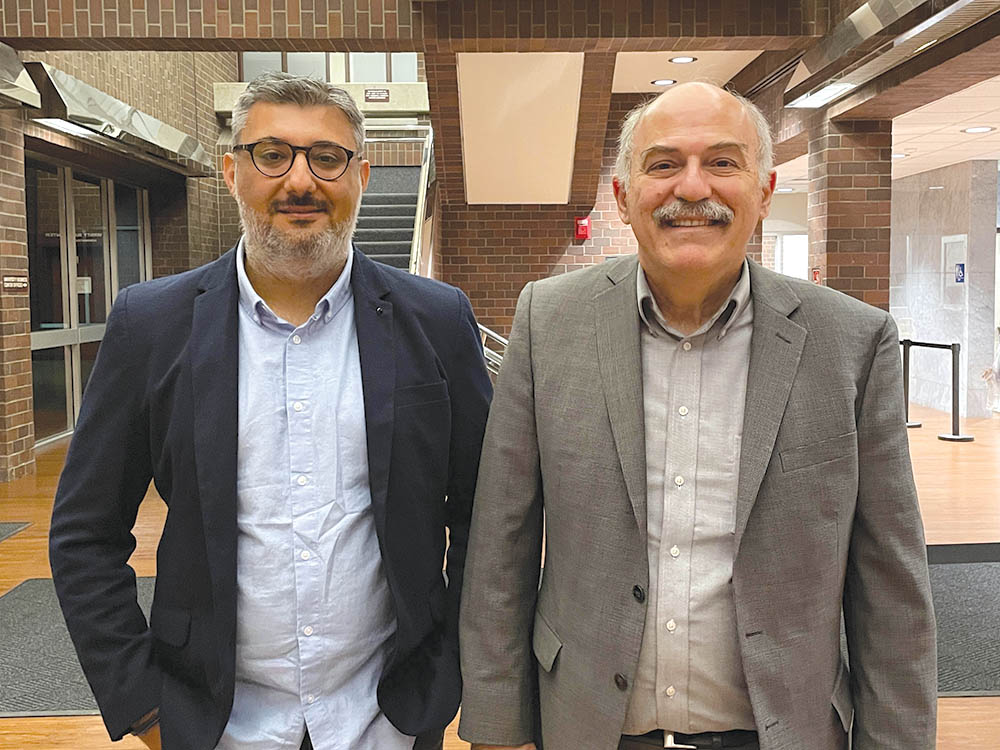
Photo: Andrew Hagopian
Christine Pambukyan
Staff Writer
“As I immersed myself in the literature and explored primary sources from Ankara to Aintab to Yerevan, it became clear to me that forced displacement, rhetoric used by the Turkish state to fend off international accusations of the Genocide and the potential Armenian demands for reparations in their eyes was a tactic in the systematic and planned effort to annihilate Ottoman Armenians in Asia Minor,” stated Dr. Ümit Kurt, Assistant Professor in the School of Humanities, Creativity Industry, and Sciences and an affiliate of the Center of the Study of Violence at the University of Newcastle, Australia.
On Friday, December 9, 2022, Dr. Kurt, author of The Armenians of Aintab: The Economics of Genocide in an Ottoman Province (Harvard University Press, 2021), was the final speaker in the Armenian Studies Fall 2022 Lecture Series, and gave a presentation on “Microhistories of the Armenian Genocide.”
In this lecture, Dr. Kurt analyzed the Armenian Genocide through the lens of the individual actors of the Genocide and the agency they have, rather than interpreted through the lens of the government. He also focused on the local elites of the regions in which the Genocide was conducted and how they acted. He did this by explaining their motives for participating in the Genocide, together with the main organizer, the ruling Committee of Union and Progress.
Dr. Kurt begins his lecture by explaining how he became interested in the study of the Armenian Genocide. “Searching for something with a flesh and blood connection to Turkey’s past… my past, and my very own upbringing as a Turk… I learned more of the mass atrocities and forced deportations carried out in the waning years of the Ottoman Empire. I learned as well as of the early purges conducted by the Ottoman ruling elites against non-Muslim groups within the Empire – Armenians first and foremost in the late nineteenth and early twentieth century,” stated Dr. Kurt.
Dr. Kurt explained how he grew up in a Turkish household, where his Arab father forbade his Kurdish mother from teaching their children about her culture and language. This left a deep impact on his feelings about the country that he grew up in. “As a child, I used to eavesdrop while my mother was speaking Kurdish with my grandmother and aunts. When my father came in the room, the conversation suddenly switched to Turkish. This led me to develop a certain kind of resistance to everything about Turkishness and the nationalism surrounding it,” added Dr. Kurt.
Next, Dr. Kurt explained how historiography has changed in the last decade. In contrast to the study of holocaust history, which has access to numerous primary sources, it was more difficult to find information on local histories of the Armenian Genocide.
“Until the late 1990s, Middle East Studies programs in the English-speaking world were dominated by scholars who refused to admit that there was an Armenian Genocide. It was they, like Stanford Shaw and Bernard Lewis, who were training their graduate students; writing reviews like Andrew Mungo; and publishing books which would then be cited by Justin McCarthy, creating an academic loop,” stated Dr. Kurt.
Dr. Kurt added that this has recently changed. Many scholars of diverse backgrounds, including Armenians, Kurds, Turks, and Americans, have restructured the narrative and provided more accurate histories of the atrocities and events that took place during the Armenian Genocide. Despite this, Dr. Kurt maintained that “existing studies unfold the narrative of the annihilation of the Armenians and other minority communities primarily from the perspective of the perpetrators, central political elites, and European political actors, rather than from the intersecting perspectives of the international, national, and local agents.”
This historiography also lacks primary sources about the violence perpetrated against Armenians, Assyrians, and Greeks.
Dr. Kurt explained that “in comparison with the Holocaust, as well as other genocidal acts and mass murders such as in Rwanda and Cambodia… we have to date essentially no substantial understanding of the motives of grass-root perpetrators who enabled and enacted the Armenian Genocide.” He added that in his research, he found that “this lack of information on the motives leading to the destruction of Armenians is because such information is usually extracted through a systematic study of archival resources, testimonial accounts, trial records, and the perpetrator accounts.”
“Being the perpetrator of a mass crime such as genocide is not unique to certain individuals… none came into this world as perpetrators,” emphasized Dr. Kurt. Therefore, it is important to study the local perpetrators, the people who were present for the local massacres, to understand why and how the Genocide was carried out.
Dr. Kurt concluded his presentation by mentioning that “the Armenian Genocide was a mass murder committed by a wide range of perpetrators. The individuals involved in this criminal acted in accordance with their own decisions regardless of the circumstances; therefore, individual responsibility is essential.”
“The Armenian Genocide was as much a bottom-up process as it was top-down process,” concluded Dr. Kurt. “The relations between the central powers and local authorities were not unidirectional but multifaceted.”
Dr. Kurt’s presentation, along with other lectures in the Armenian Studies Program Lecture Series, are archived on the Armenian Studies YouTube Channel at https://bit.ly/armenianstudiesyoutube.
 Hye Sharzhoom Armenian Action
Hye Sharzhoom Armenian Action